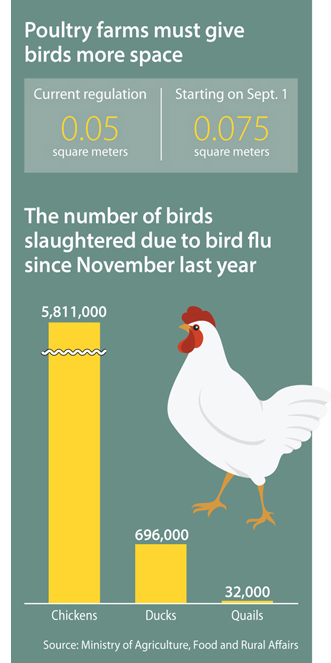Chicken farmers will have to use bigger cages

According to the Ministry of Agriculture, Food and Rural Affairs on Monday, the minimum legal size of cages in local poultry farms will be expanded from 0.05 square meters (5 square feet) per bird to 0.075 square meters. Providing at least 0.075 square meters of space per hen is the standard currently in place among the European Union countries.
The new standard will go into effect on Sept. 1 with a grace period of seven years so existing farms can gradually upgrade their facilities.
An official from the Agriculture Ministry explained that the regulations announced Monday are a follow-up to measures introduced in the wake of the pesticide egg scandal that swept the country about a year ago.
“It was pointed out that overpopulation of hens in tight spaces caused the spread of ticks and mites, which were essentially the cause of the contaminated egg scandal,” explained the official.
Chickens stuck in small cages are unable to remove ticks on their own, which forces farmers to spray pesticides to kill them. These pesticides, used to keep chickens “healthy,” end up in the eggs they lay, which are consumed by the public. The pesticide-egg scare last year led to a drastic fluctuation in the price of eggs as the government scrambled to provide safe eggs to consumers, going as far as importing them from abroad.
“It was apparent that we needed to improve the living conditions of the birds to prevent or minimize such incidents in the future,” the official said.
The new standard is also a part of the government’s effort to prevent the spread of a highly pathogenic strain of the H5N6 avian influenza, a deadly virus that can also infect humans.
In addition to the enlargement of the bird cages, the government will also make it obligatory for farmers to install cameras at the entrance of their farms and inside hen houses.
This could help authorities figure out how a virus has spread and anticipate where it might end up next. Farms will also be required to install inspection facilities when they register for a business permit.
Bird flu has been a headache for the Korean government, spreading through the country almost every year.
The latest case detected was in March when a highly pathogenic strain of H5N6 avian influenza was discovered on some farms in Gyeonggi and South Chungcheong.
The government slaughtered more than 200,000 birds that month. More than six million birds were culled since November last year, according to the Agriculture Ministry.
“Bird flu occurs during the winter starting in November,” explained the Agriculture Ministry’s official. “We designate the months from October to May as needing extensive disinfection.”
Some experts, however, say that expanding the size of cages may not be sufficient, explaining that EU countries are banned from raising hens in battery cages and required to use so-called enriched cages instead, which are cleaner and more comfortable for the birds.
BY CHOI HYUNG-JO [choi.hyungjo@joongang.co.kr]










with the Korea JoongAng Daily
To write comments, please log in to one of the accounts.
Standards Board Policy (0/250자)